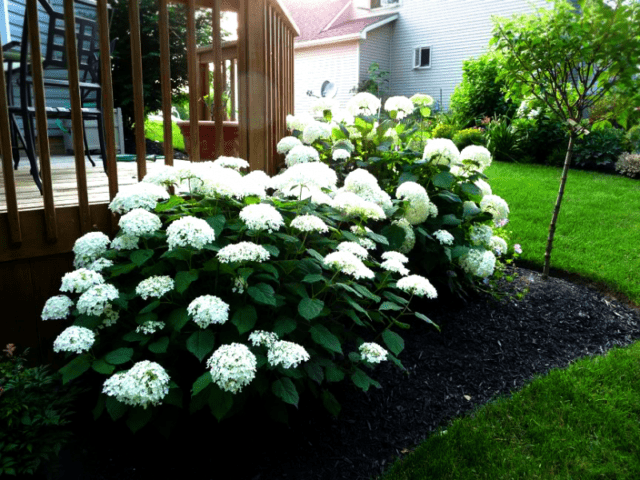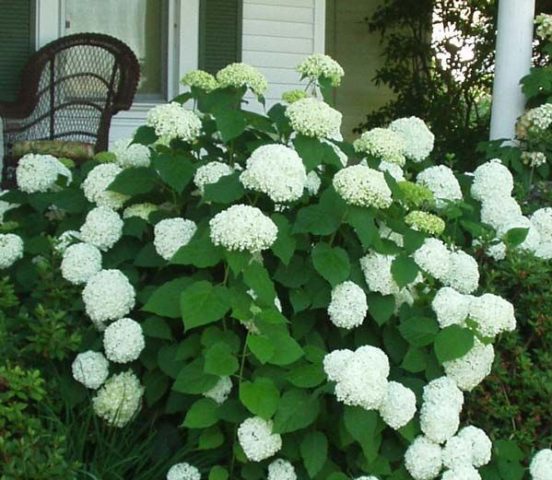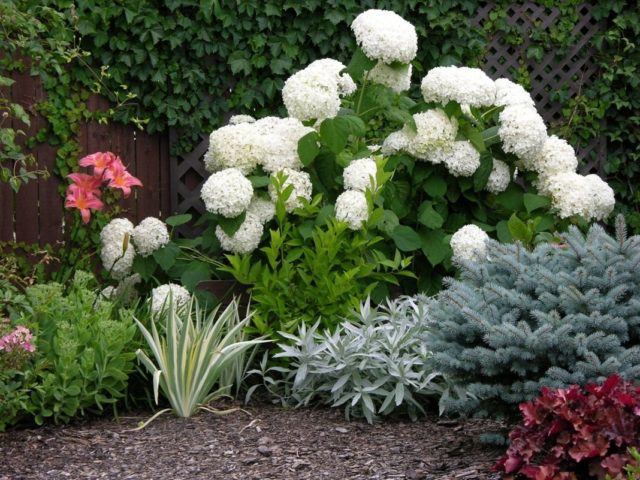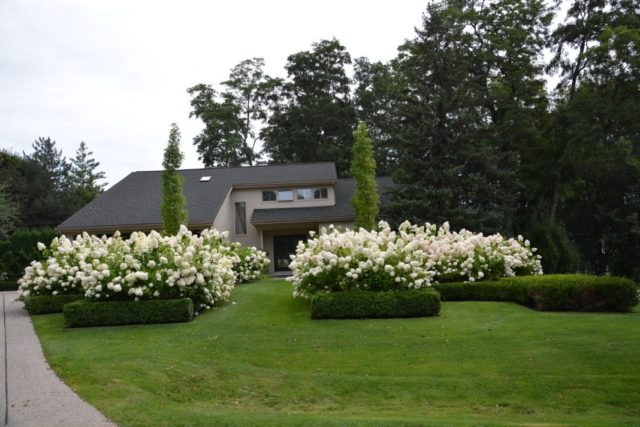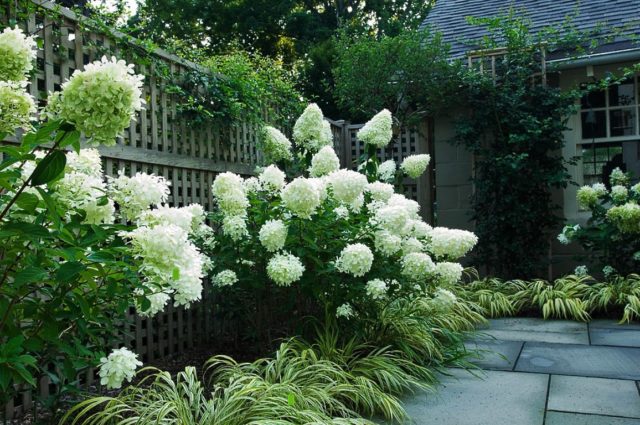Contents
In the garden, next to the terrace and not far from the entrance to the house, a bush with lush, large inflorescences looks good, for example, the Bounty hydrangea tree. It produces many white flowers that literally dot the tree-like bush with strong shoots and peduncles. Due to its high winter hardiness, this hydrangea is suitable for growing in different regions, including the Urals and Siberia.
Description of hydrangea variety Bounty
Bounty is one of the most attractive varieties of hydrangea with lush spherical inflorescences. Throughout the summer and early autumn, the bush produces abundant white flowers. They always confidently look up, even after rain and during winds. Peduncles and shoots of the plant are very strong, thanks to which the crown does not break even in drafts.
In height, the bush usually grows up to 1 m, and about 1,5 m wide. Its shape must be corrected – for this, formative pruning is carried out every spring. The shoots of the hydrangea tree are slightly covered with fluff, and the large, rather wide leaves, on the contrary, are bare. They are painted in a typical green color, on the reverse side they can be a little bluish.
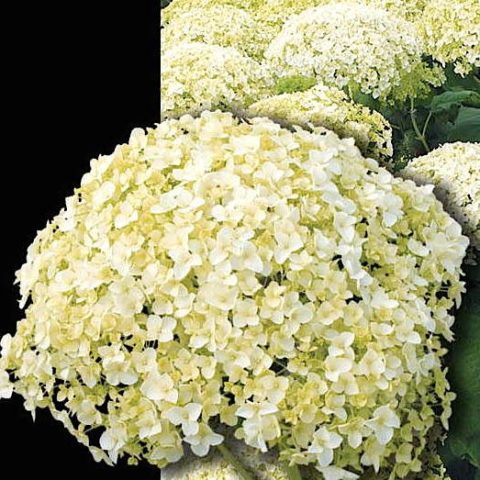
Large spherical inflorescences of hydrangea Bounty in diameter reach 25-35 cm
Hydrangea Bounty in landscape design
The tree-like hydrangea Hydrangea Arborescens Bounty has a high decorative value not only due to lush inflorescences, but also interesting ovoid leaves. This is a very attractive, completely self-sufficient shrub that looks great, especially in single plantings. Although it is absolutely not forbidden to use it to create compositions with other colors.
There are a lot of options for using Bounty in landscape design – here are some ideas for inspiration:
- Flowers in front of the entrance decorate the place and attract attention.

- Often they are planted next to the terrace, so that everyone can admire the abundant white inflorescences.

- Since the hydrangea bush grows 1-1,5 m, it is better to place it in the background in compositions.

- White flowers look great against the backdrop of a lawn, especially if there is a hedge frame next to them.

- Often they are planted near the fence. Hydrangea Bounty needs protection from the wind, so in this case, aesthetic considerations are well combined with practical ones.

Winter hardiness of bounty hydrangea
In the description of the characteristics of the Bounty tree hydrangea variety, it is stated that the plant can withstand winter colds down to -29 degrees. Moreover, in severe frosts, the tree freezes slightly, young shoots may die, but with the onset of the new season, the crown is restored almost completely.
It is suitable for growing in the conditions of the Middle Strip, the North-West, and even more so in the southern regions. There is evidence that Bounty is successfully grown in the Urals, as well as in the south of Western Siberia. But it is important to consider that frosty weather with temperatures below 30 degrees sets in these areas every winter for several days. Therefore, hydrangea needs mandatory shelter and mulching.
Planting and caring for hydrangea tree bounty
A feature of the Bounty tree hydrangea is its light-loving nature. Other varieties also like lighted places, but they may suffer due to abundant sunlight. Bounty can be safely planted even in open areas.
Selection and preparation of the landing site
When choosing a site, you should pay attention to several features:
- It should be a spacious, attractive place.
- The soil is light, fertile, slightly acidic or neutral, but not alkaline.
- In the south, it is better to hide the hydrangea in the light shade of trees, shrubs or buildings.
- In the north, you can choose an open place.
- It is advisable to place the Bounty hydrangea near natural shelters or buildings, as it does not like strong winds.
Rules of landing
Hydrangea loves chernozems and light loams, but grows quite well even on depleted soils. For successful cultivation, it is necessary to choose the soil. Its composition may be as follows:
- leaf ground (2 parts);
- humus (2 parts);
- peat (1 part);
- sand (1 part).
Or this:
- leaf ground (4 parts);
- sod land (2 parts);
- sand (1 part).
In order for the tree seedling to take root well, you can use a special compound for rhododendrons. Hydrogel granules (pre-moistened) are also added to the mixture. They retain water well and protect the plant from drought.
The landing sequence is as follows:
- They dig a hole with a diameter and depth of 50 cm. Too large a hole is not needed – the root system of hydrangeas is superficial.
- Water it with water (2-3 buckets).
- They fill up the earth.
- The shoot is set in the center and covered with earth so that its root neck is slightly above the soil surface.
- Then water again and mulch with sawdust, needles (layer height 6 cm).
Watering and top dressing
Watering should be plentiful – in this case, the tree-like bush will indeed produce flowers throughout the summer and early autumn. The mode is chosen as follows:
- If there is a lot of precipitation, it is not necessary to water – additional water is given only when the soil dries.
- If there is little rain, watering is organized once a month (1 buckets per bush).
- If a drought sets in, you will need to give 2 buckets weekly. In rare cases, water even 2 times a week.
Feed the plant several times a season:
- In the spring – nitrogen fertilizers.
- During the summer (monthly) – potassium and phosphorus for lush flowering.
- The last time you can fertilize in the first half of August, after which the top dressing is stopped.
Pruning Hydrangea Bounty
Bounty arbitrarily tends to take a beautiful spherical shape. However, periodically the bush of this tree-like hydrangea should be cut. Do this at the very beginning of spring (March), before active sap flow. At the Bounty tree hydrangea, branches are pruned:
- old, damaged;
- strongly spoiling the appearance (they form a hemisphere, the extra branches are removed, leaving 2-3 buds);
- shoots growing in depth (crown thinning).
A similar procedure can be repeated in the fall – for example, at the end of September or in October, a week before the first frost.
Preparation for winter
Since the Bounty variety can withstand frosts down to -29 degrees, and winters in Our Country (especially in Siberia) are often unpredictable, it is better to prepare this tree-like plant for winter. To do this, it is mulched with needles, sawdust and fallen leaves (layer 6-7 cm). You can also spud with earth (height no more than 10 cm).
In Siberia and the Urals, it is recommended to additionally cover the Bounty hydrangea, especially young seedlings. To do this, you can use burlap, agrofiber and even plastic wrap – the plant tolerates high humidity well.
Reproduction
The main methods of propagation of Bounty hydrangea are cuttings and layering. In the first case, it is necessary to cut the apical shoots in early June. Each future cutting should have 3 pairs of leaves. The lower one is completely removed, and the rest is shortened by half.
Then they act like this:
- The cuttings are treated with “Epin” for an hour (a solution of 0,5 ml per 1 liter).
- First, they are planted for 2-3 months in wet sand, covered with a jar and constantly watered.
- At the end of summer, they are planted in the ground, left to winter indoors.
- The following summer, the cuttings can be transplanted to a permanent place.
It’s also easy to get credits. To do this, in early spring, the lower shoots are fixed to the ground, leaving only the crown. They are watered, fed, and then in September they are separated from the mother hydrangea bush. The next season, they are transplanted to a permanent place.
Diseases and pests
Bounty tree hydrangea tolerates quite well not only frosts, but also the effects of diseases and pests. It is usually affected by diseases that are typical for most varieties of hydrangeas and other crops, for example:
- chlorosis (yellowing of leaves);
- powdery mildew;
- leaf spot;
- root rot.
Fungicides are used for treatment. To cope with chlorosis, nitrogen fertilizers can be applied (but not in the second half of summer). An alternative option is to use a mixture of a solution of citric acid (5 g) and iron sulfate (3 g) in 1 liter of water. Since chlorosis is usually associated with insufficient soil acidity, it can be treated with 9% vinegar (100 ml per 10 liters of water), fresh manure or needles can be added.
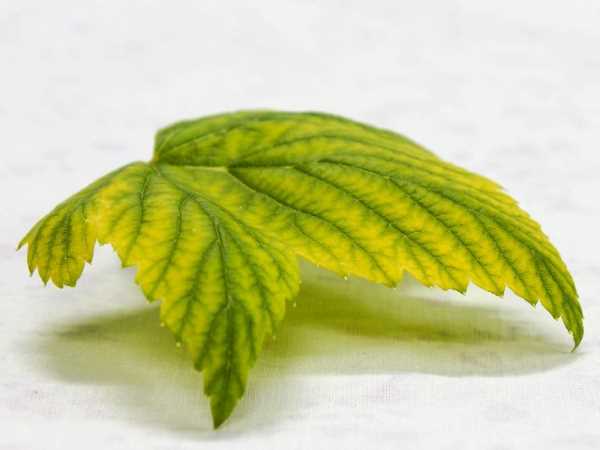
Hydrangea tree chlorosis is associated with insufficient soil acidity and nitrogen fertilizer deficiencies.
The main pests of the plant are aphids and spider mites. For prevention and treatment, insecticides and folk remedies are used. For example, you can spray with a solution of a glass of ash in 10 liters of water, 100 g of laundry soap shavings, 20 tablespoons of hydrogen peroxide also per 10 liters and other mixtures.
Conclusion
The attractive Bounty hydrangea is one of those flowering shrubs that makes an excellent addition to a garden, even when planted alone. Moreover, this variety tolerates both shaded and bright places well. If you provide normal feeding and watering, the hydrangea will indeed bloom throughout the summer and even in early autumn.
Hydrangea Bounty Reviews
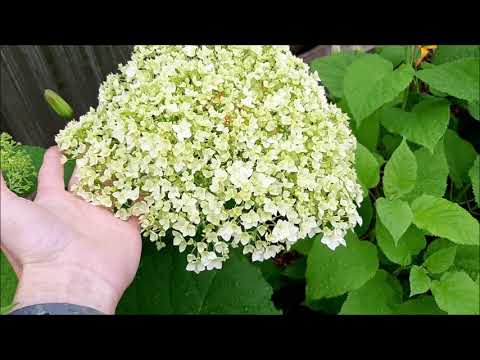

Смотрите это видео на YouTube










